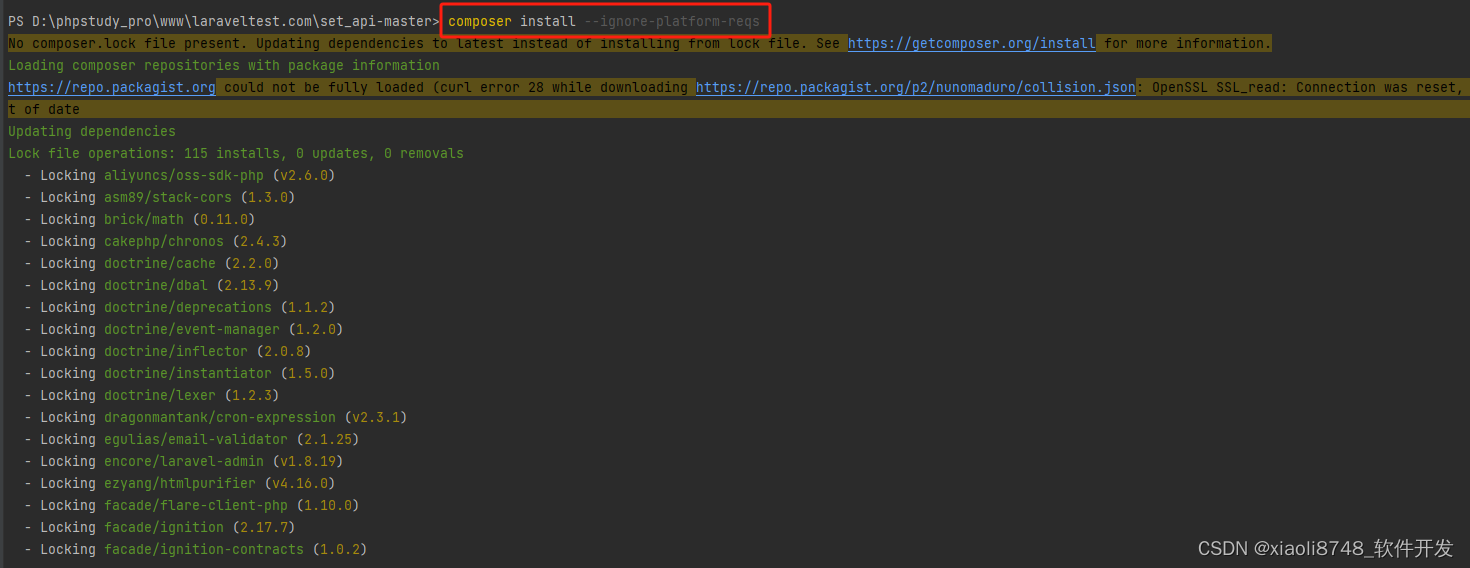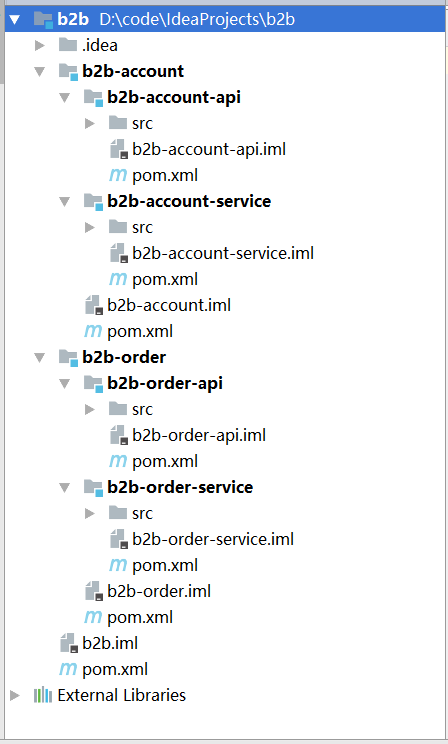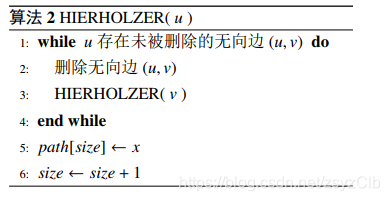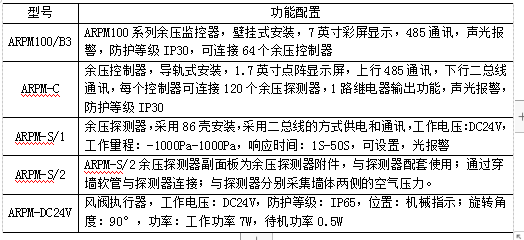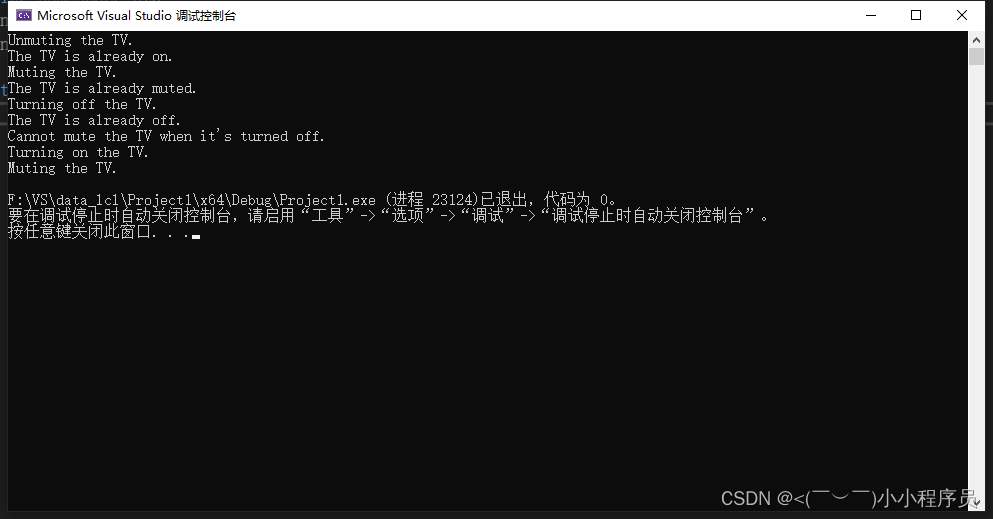在上一篇中我们围绕了Spring Boot 集成了RESTful API项目,但是我们在实际开发中,我们的一个RESTful API有可能就要服务多个不同的开发人员或者开发团队,包括不限于PC,安卓,IOS,甚至现在的鸿蒙OS,web开发等等。为了减少与其他团队平时开发期间的频繁沟通成本,我们一般会选择创建一个相关的文档来记录所有的接口细节,也就是我们常常在实际开发中的接口文档。
- 但是我们采用接口文档进行记录的时候,发现,由于接口众多,并且他们的细节比较复杂,需要我们考虑不同场景的HTTP请求,甚至HTTP的相关头部信息,内容等,并且我们在创建这样的接口文档的时候,费时费力,很多的时候,我们都统计不全,甚至还会出现错误,这是因为人力统计的时候很容易出现差错,这也很正常。
- 并且随着时间的增加,我们对系统进行改动,不免也会对相关接口进行改动,这个只要是做过开发的都知道,这里调接口,那里调接口,我们就需要对文档进行修改,但是我们在开发过程中,发现代码和文档处于两个阶级,除非老大有严格的管控,不然就会造成很多问题。
这个时候,我们发现刚好有一种技术可以解决我们的问题,也就是Swagger2,他可以轻松的整合到Spring Boot中,并于Spring MVC 程序配合组织处很强大哦的RESTful API文档,极大的减少了我们创建文档的工作量,同时进一步将内容整合到我们的实现代码中,让代码修改和文档维护成为一体,同时修改,同时记录,让我们在修改代码的同时也修改了文档说明。
此外Swagger2 提供了强大的页面测试功能来调试每个RESTful API。具体效果如下图所示。
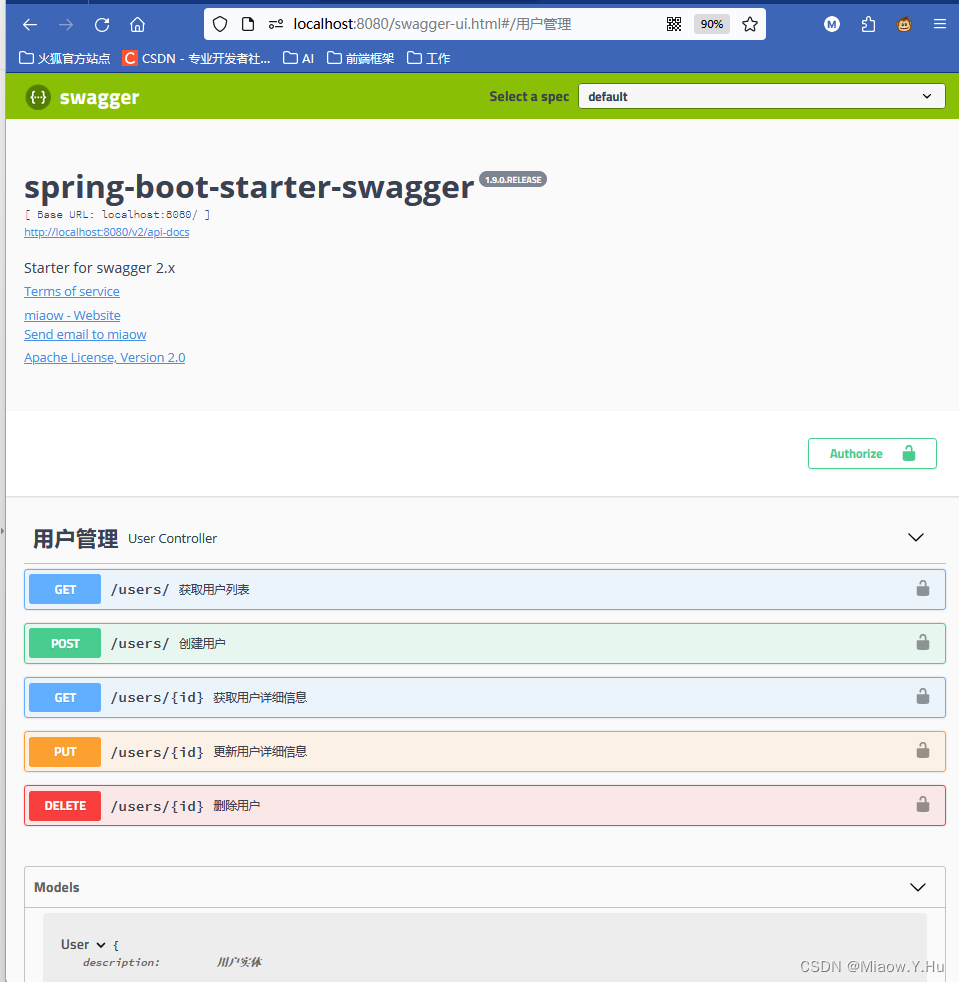
准备工作
我们需要有一个Spring Boot 实现的RESTful API工程,我们在上一篇就以及涉及到了,如果你没有接触过RESTful API,欢迎参照上一篇一起食用更佳。
Spring Boot整合Swagger 2
第一步,添加依赖,老样子,这里就不在详细描述了,如下:
<dependencies><!-- Spring Boot Web --><dependency><groupId>org.springframework.boot</groupId><artifactId>spring-boot-starter-web</artifactId></dependency><!-- Springfox Swagger2 --><dependency><groupId>io.springfox</groupId><artifactId>springfox-swagger2</artifactId><version>2.9.2</version> <!-- 请使用最新版本 --></dependency><!-- Springfox Swagger UI --><dependency><groupId>io.springfox</groupId><artifactId>springfox-swagger-ui</artifactId><version>2.9.2</version> <!-- 请使用最新版本 --></dependency>
</dependencies>
第二步:在Spring Boot的启动类中添加一个@EnableSwagger2Doc 注解,如下:
@EnableSwagger2Doc
@SpringBootApplication
public class Application {public static void main(String[] args) {SpringApplication.run(Application.class, args);}
}
第三步创建一个User实体对象,并给相关实体添加Swagger2 自带的接口,@ApiModel添加到实体类上,@ApiModelProperty添加到具体的属性之上,用于描述具体属性
@ApiModel(description="用户实体")
public class User {@ApiModelProperty("用户编号")private Long id;@ApiModelProperty("用户姓名")private String name;@ApiModelProperty("用户年龄")private Integer age;public Long getId() {return id;}public void setId(Long id) {this.id = id;}public String getName() {return name;}public void setName(String name) {this.name = name;}public Integer getAge() {return age;}public void setAge(Integer age) {this.age = age;}
}
第四步,我们在application.properties文件上配置有关Swagger2的相关属性。
swagger.title=spring-boot-starter-swagger
swagger.description=Starter for swagger 2.x
swagger.version=1.9.0.RELEASE
swagger.license=Apache License, Version 2.0
swagger.licenseUrl=https://www.apache.org/licenses/LICENSE-2.0.html
swagger.termsOfServiceUrl=https://github.com/dyc87112/spring-boot-starter-swagger
swagger.contact.name=miaow
swagger.contact.url=https://luoxiaohei520.github.io
swagger.contact.email=miaow@qq.com
swagger.base-package=com.miaow
swagger.base-path=/**
其中参数的相关含义如下:
swagger.title:标题
swagger.description:描述
swagger.version:版本
swagger.license:许可证
swagger.licenseUrl:许可证URL
swagger.termsOfServiceUrl:服务条款URL
swagger.contact.name:维护人
swagger.contact.url:维护人URL
swagger.contact.email:维护人email
swagger.base-package:swagger扫描的基础包,默认:全扫描
swagger.base-path:需要处理的基础URL规则,默认:/**
更多配置请参照官方文档
此时启动项目,访问链接: http://localhost:8080/swagger-ui.html
发现页面全是英文的。
第五步,我们来对Controller层的相关对象和方法进行API注解说明,在第四步我们发现通过浏览器访问,整个界面都是英文或者遵循代码定义的名称产生的,对用户并不友好,于是我们通过相关注解来给API增加说明:@Api,@ApiOperation注解来给API增加说明、通过@ApiImplicitParam、@ApiModel、@ApiModelProperty注解来给参数增加说明。
@Api(tags = "用户管理")
@RestController
@RequestMapping(value = "/users") // 通过这里配置使下面的映射都在/users下
public class UserController {// 创建线程安全的Map,模拟users信息的存储static Map<Long, User> users = Collections.synchronizedMap(new HashMap<>());@GetMapping("/")@ApiOperation(value = "获取用户列表")public List<User> getUserList() {List<User> r = new ArrayList<>(users.values());return r;}@PostMapping("/")@ApiOperation(value = "创建用户", notes = "根据User对象创建用户")public String postUser(@RequestBody User user) {users.put(user.getId(), user);return "success";}@GetMapping("/{id}")@ApiOperation(value = "获取用户详细信息", notes = "根据url的id来获取用户详细信息")public User getUser(@PathVariable Long id) {return users.get(id);}@PutMapping("/{id}")@ApiImplicitParam(paramType = "path", dataType = "Long", name = "id", value = "用户编号", required = true, example = "1")@ApiOperation(value = "更新用户详细信息", notes = "根据url的id来指定更新对象,并根据传过来的user信息来更新用户详细信息")public String putUser(@PathVariable Long id, @RequestBody User user) {User u = users.get(id);u.setName(user.getName());u.setAge(user.getAge());users.put(id, u);return "success";}@DeleteMapping("/{id}")@ApiOperation(value = "删除用户", notes = "根据url的id来指定删除对象")public String deleteUser(@PathVariable Long id) {users.remove(id);return "success";}
}
之后再通过:http://localhost:8080/swagger-ui.html 访问,点击相关信息,可以看到具体的参数和相关属性。
还可以相关提示进行测试:
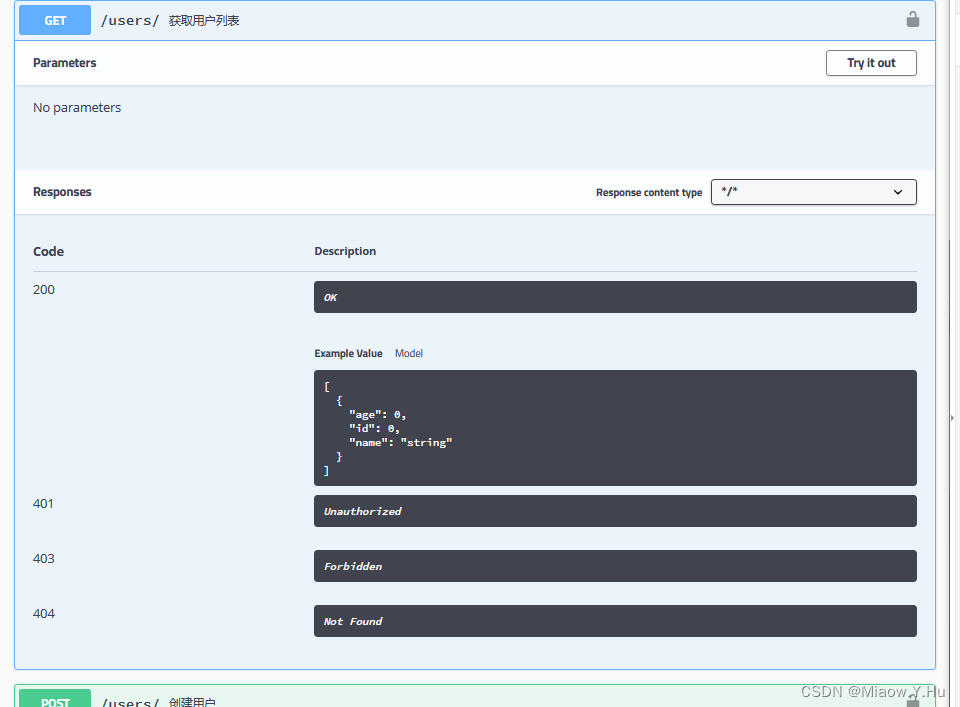


在上图请求的页面中,我们看到user的Value是个输入框,是的,Swagger除了查看接口功能外,还提供了调试测试功能,我们可以点击上图中右侧的Model Schema(黄色区域:它指明了User的数据结构),此时Value中就有了user对象的模板,我们只需要稍适修改,点击下方“Try it out!”按钮,即可完成了一次请求调用!
此时,你也可以通过几个GET请求来验证之前的POST请求是否正确。
